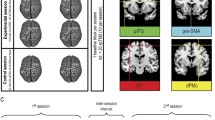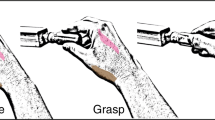Abstract
In order to clarify the functional role of the supplementary motor area (SMA) and its rostral part (pre-SMA) in relation to the rate of repetitive finger movements, we recorded movement-related cortical potentials (MRCPs) directly from the surface of the mesial frontal lobe by using subdural electrode grids implanted in four patients with intractable partial epilepsy. Two subregions in the SMA were identified based on the anatomical location and the different response to cortical stimulation. In three of the four subjects, we also recorded MRCPs from the surface of the lateral convexity covering the primary sensorimotor areas (SI-MI), which were defined by cortical stimulation and SEP recording. The subjects extended the middle finger or opposed the thumb against other fingers of the same hand at a self-paced rate of 0.2 Hz (slow) and 2 Hz (rapid), each in separate sessions. As a result, pre- and postmovement potentials were clearly seen at the SI-MI in both slow- and rapid-rate movements. By contrast, in the SMA, especially in the pre-SMA, premovement potentials were not seen and postmovement potentials were seldom seen in the rapid rate movement. In the slow-rate condition, pre- and postmovement potentials were clearly seen in both the pre-SMA and the SMA proper. In conclusion, the SMA, especially the pre-SMA, is less activated electrophysiologically in the rapid-rate movements, while the SI-MI remains active regardless of the movement rate.
Similar content being viewed by others
References
Aizawa H, Inase M, Mushiake H, Shima K, Tanji J (1991) Reorganization of activity in the supplementary motor area associated with motor learning and functional recovery. Exp Brain Res 84:668–671
Allison T, McCarthy G, Luby M, Puce A, Spencer DD (1996) Localization of functional regions of human mesial cortex by somatosensory evoked potential recording and by cortical stimulation. Electroencephalogr Clin Neurophysiol 100:126–140
Catalan MJ, Honda M, Weeks RA, Cohen LG, Hallett M (1998) The functional neuroanatomy of simple and complex sequential finger movements: a PET study. Brain 121:253–264
Deecke L (1990) Electrophysiological correlates of movement initiation. Rev Neurol 146:612–619
Dum RP, Strick PL (1996) Spinal cord terminations of the medial wall motor areas in macaque monkeys. J Neurosci 16:6513–6525
Eccles JC (1982) The initiation of voluntary movements by the supplementary motor area. Arch Psychiatr Nervenkr 231:423–441
Engel J Jr (1987) Outcome with respect to epileptic seizures. In: Engel J Jr (ed) Surgical treatment of the epilepsies. Raven, New York, pp 553–572
Fox PT, Fox JM, Raichle ME, Burde RM (1985) The role of cerebral cortex in the generation of voluntary saccades: a positron emission tomographic study. J Neurophysiol 54:348–369
Gerloff C, Toro C, Uenishi N, Cohen LG, Leocani L, Hallett M (1997) Steady-state movement-related cortical potentials: a new approach to assessing cortical activity associated with fast repetitive finger movements. Electroencephalogr Clin Neurophysiol 102:106–113
Gerloff C, Uenishi N, Nagamine T, Kunieda T, Hallett M, Shibasaki H (1998) Cortical activation during fast repetitive finger movements in humans: steady state movement-related magnetic fields and their cortical generators. Electroencephalogr Clin Neurophysiol 109:444–453
Hahn J, Liiders H (1987) Placement of subdural grid electrodes at the Cleveland Clinic. In: Engel J Jr (ed) Surgical treatment of the epilepsies. Raven, New York, pp 621–627
Halsband U, Matsuzaka Y, Tanji J (1994) Neuronal activity in the primate supplementary, presupplementary and premotor cortex during externally and internally instructed sequential movements. Neurosci Res 20:149–155
Ikeda A, Liiders HO, Burgess RC, Shibasaki H (1992) Movement-related potentials recorded from supplementary motor area and primary motor area. Role of supplementary motor area in voluntary movements. Brain 115:1017–1043
Ikeda A, Liiders HO, Burgess RC, Shibasaki H (1993) Movement-related potentials associated with single and repetitive movements recorded from human supplementary motor area. Electroencephalogr Clin Neurophysiol 89:269–277
Ikeda A, Liiders HO, Burgess RC, Sakamoto A, Klem GH, Morris HH 3rd, Shibasaki H (1995a) Generator locations of movement-related potentials with tongue protrusions and vocalizations: subdural recording in human [published erratum appears in Electroencephalogralogr Clin Neurophysiol 1995 96(5):484]. Electroencephalogr Clin Neurophysiol 96:310–328
Ikeda A, Liiders HO, Shibasaki H, Collura TF, Burgess RC, Morris HH 3rd, Hamano T (1995b) Movement-related potentials associated with bilateral simultaneous and unilateral movements recorded from human supplementary motor area. Electroencephalogr Clin Neurophysiol 95:323–334
Ikeda A, Liiders HO, Collura TF, Burgess RC, Morris HH, Hamano T, Shibasaki H (1996) Subdural potentials at orbito-frontal and mesial prefrontal areas accompanying anticipation and decision making in humans: a comparison with Bereit-schaftspotential. Electroencephalogr Clin Neurophysiol 98: 206–212
Ikeda A, Taki W, Kunieda T, Terada K, Mikuni N, Nagamine T, Yazawa S, Ohara S, Hori T, Kaji R, Kimura J, Shibasaki H (1999a) Focal ictal DC current shifts in human epilepsy as studied by subdural and scalp recording. Brain 122:827–838
Ikeda A, Yazawa S, Kunieda T, Ohara S, Terada K, Mikuni N, Nagamine T, Taki W, Kimura J, Shibasaki H (1999b) Cognitive motor control in human pre-supplementary motor area studied by subdural recording of discrimination/selection-related potentials. Brain 122:915–931
Ivry RB, Keele SW, Diener HC (1988) Dissociation of the lateral and medial cerebellum in movement timing and movement execution. Exp Brain Res 73:167–180
Jenkins IH, Passingham RE, Brooks DJ (1997) The effect of movement frequency on cerebral activation: a positron emission tomography study. J Neurosci 151:195–205
Kornhuber HH, Deecke L (1965) Hirnpotentialanderungen bei Willkurbewegungen und passiven Bewegungen des Menschen: Bereitschaftspotential und reafferente Potentiale. Pflugers Arch 284:1–17
Lim SH, Dinner DS, Pillay PK, Liiders H, Morris HH, Klem G, Wyllie E, Awad IA (1994) Functional anatomy of the human supplementary sensorimotor area: results of extraoperative electrical stimulation. Electroencephalogr Clin Neurophysiol 91:179–193
Lüders H, Lesser RP, Dinners DS, Morris HH, Hahn JF, Friedman L, Skipper G, Wyllie E, Friedmann D (1987) Chronic intracranial recording and stimulation with subdural electrodes. In: Engel J Jr (ed) Surgical treatment of the epilepsies. Raven, New York, pp 297–321
Luppino G, Matelli M, Camarda R, Rizzolatti G (1993) Cortico-cortical connections of area F3 (SMA-proper) and area F6 (pre- SMA) in the macaque monkey. J Comp Neurol 338: 114–140
Matsuzaka Y, Aizawa H, Tanji J (1992) A motor area rostral to the supplementary motor area (presupplementary motor area) in the monkey: neuronal activity during a learned motor task. J Neurophysiol 68:653–662
Nagamine T, Kajola M, Salmelin R, Shibasaki H, Hari R (1996) Movement-related slow cortical magnetic fields and changes of spontaneous MEG- and EEG-brain rhythms. Electroencephalogr Clin Neurophysiol 99:274–286
Neshige R, Liiders H, Shibasaki H (1988) Recording of movement-related potentials from scalp and cortex in man. Brain 111:719–736
Rizzolatti G, Luppino G, Matelli M (1996) The classic supplementary motor area is formed by two independent areas. Adv Neurol 70:45–56
Sadato N, Campbell G, Ibanez V, Deiber M, Hallett M (1996a) Complexity affects regional cerebral blood flow change during sequential finger movements. J Neurosci 16:2691–2700
Sadato N, Ibanez V, Deiber MP, Campbell G, Leonardo M, Hallett M (1996b) Frequency-dependent changes of regional cerebral blood flow during finger movements. J Cereb Blood Flow Metab 16:23–33
Sakamoto A, Liiders H, Burgess R (1991) Intracranial recordings of movement-related potentials to voluntary saccades. I Clin Neurophysiol 8:223–233
Scherg M, Picton TW (1991) Separation and identification of event-related potential components by brain electrical source analysis. Electroencephalogralogr Clin Neurophysiol [Suppl] 42:24–37
Schlaug G, Sanes IN, Thangaraj V, Darby DG, lancke L, Edelman RR, Warach S (1996) Cerebral activation covaries with movement rate. Neuroreport 7:879–883
Shibasaki H, Barrett G, Halliday E, Halliday AM (1980) Components of the movement-related cortical potential and their scalp topography. Electroencephalogr Clin Neurophysiol 49: 213–226
Shibasaki H, Sadato N, Lyshkow H, Yonekura Y, Honda M, Nagamine T, Suwazono S, Magata Y, Ikeda A, Miyazaki M, et al. (1993) Both primary motor cortex and supplementary motor area play an important role in complex finger movement. Brain 116:1387–1398
Talairach J, Tournoux P (1988) Co-planar stereotaxic atlas of the human brain. Thieme, Stuttgart
Tanji I (1994) The supplementary motor area in the cerebral cortex. Neurosci Res 19:251–268
Tanji J, Shima K (1994) Role for supplementary motor area cells in planning several movements ahead. Nature 371:413–416
Toro C, Matsumoto I, Deuschl G, Roth BJ, Hallett M (1993) Source analysis of scalp-recorded movement-related electrical potentials. Electroencephalogr Clin Neurophysiol 86:167–175
Wiesendanger M (1986) Recent developments in studies of the supplementary motor area of primates. Rev Physiol Biochem Pharmacol 103:1–59
Wise SP (1996) Evolutionary and comparative neurobiology of the supplementary sensorimotor area. Adv Neurol 70:71–83
Yazawa S, Ikeda A, Kunieda T, Nagamine T, Taki W, Kimura I, Shibasaki H (1997) Movement preparation in human pre-supplementary motor area as studied by subdural recording of Bereitschaftspotential. Neurosci Res [Suppl 21] S191
Yazawa S, Ikeda A, Kunieda T, Mima T, Nagamine T, Ohara S, Terada K, Taki W, Kimura I, Shibasaki H (1998) Human supplementary motor area is active in preparation for both voluntary muscle relaxation and contraction: subdural recording of Bereitschaftspotential. Neurosci Lett 244:145–148
Zilles K, Schlaug G, Geyer S, Luppino G, Matelli M, Qu M, Schleicher A, Schormann T (1996) Anatomy and transmitter receptors of the supplementary motor areas in the human and nonhuman primate brain. Adv Neurol 70:29–43
Author information
Authors and Affiliations
Corresponding author
Additional information
Published online: 30 August 2000
Rights and permissions
About this article
Cite this article
Kunieda, T., Ikeda, A., Ohara, S. et al. Different activation of presupplementary motor area, supplementary motor area proper, and primary sensorimotor area, depending on the movement repetition rate in humans. Exp Brain Res 135, 163–172 (2000). https://doi.org/10.1007/s002210000519
Received:
Accepted:
Issue Date:
DOI: https://doi.org/10.1007/s002210000519




